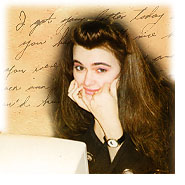
Saving Private Art
Introduction
When Rebecca Hargrave graduated from the Florida School of the Arts
in 1989, she had a career goal of not having a career. She
traveled north, stopped in Nashville for a while, then landed
in Cincinnati where she found a day job at a digital design
studio that specialized in state-of-the-art prepress for some top-flight advertising agencies.
The studio had a hook: they used modems to get data from the ad
agencies into the prepress system. Rebecca quickly got the
hang of telecommunications and temperamental ad agency art directors alike and was
soon promoted to Production Manager. Her
considerable computer skills and artistic background soon helped her become a
temperamental ad agency art director herself.
By 1992, after two years of long days and even longer
nights of “you want it when?”
she felt the need for a more creative outlet. Along with
some friends, she put the modems and some software called “First Class”
to work building community sites. These bulletin board systems, or “BBS’s” were telephone-based networks that supported devoted online communities in the pre-Web days.
“I love it when people complain about how limiting
the web and HTML is.” Rebecca says. “My first thought
is that they are missing the point of what the Web is about anyway.
Yet I also recall
First Class, with its 8-bit color, 2400 baud modems, and limited customization capabilities.
I’ll never forget having to squeeze all my interface graphics into a single ‘settings file’ that
had to be under a megabyte if I wanted people to download
the software.”
By 1994, designing for the Web had become her full-time job.
Her work didn’t go unnoticed:
Project Cool, for example, has listed
a cool baker’s dozen of her creations as notable examples
of how the Web should be used.
 One of her best-known creations is
Private Art: WWII Letters To and From Home.
The titular Private Art is Art Pranger.
Rose Pranger, Art's wife, had discovered Art’s letters
from WWII in an attic and made a project — Rose likes projects — of
typing them into a word processing program to preserve the decaying letters for her family’s
future generations. Rebecca read the letters and called Rose
aside, “There’s a bigger story here than just preserving
letters for the family. If other people could read this…it’s
an Everyman story.”
One of her best-known creations is
Private Art: WWII Letters To and From Home.
The titular Private Art is Art Pranger.
Rose Pranger, Art's wife, had discovered Art’s letters
from WWII in an attic and made a project — Rose likes projects — of
typing them into a word processing program to preserve the decaying letters for her family’s
future generations. Rebecca read the letters and called Rose
aside, “There’s a bigger story here than just preserving
letters for the family. If other people could read this…it’s
an Everyman story.”
Private Art debuted on the Web in 1997. In this edition of Trip-M, Mappa.Mundi Magazine’s
editor, Marty Lucas, interviews Rebecca Hargrave about the making of Private Art,
and how the ancient art of storytelling is changing to adapt to the digital age.
To the Interview » One of the Family.
Copyright © 1999, 2000 media.org.
|